9 Key Metrics for Local SEO Success [with Insights from Marketers]
Feb 20, 2025
The key metrics for local SEO success measure your business visibility in target geographic areas and pinpoint areas for improvement.
For businesses with multiple locations, tracking the right SEO KPIs can help attract local customers by boosting your local authority.
In this blog post, we're going to look at some of the key metrics for measuring local SEO success that let you know how well your efforts are working.
Why Track Local SEO Metrics?
Tracking local SEO metrics is important for enhancing your business's online visibility and community engagement.
Here’s why understanding these metrics is advantageous:
Better Business Visibility in the Local 3-Pack
Securing a spot in Google’s local 3-pack can dramatically increase your company visibility. By monitoring your rankings and other relevant local SEO metrics, you can improve your local rankings and maximize your local business visibility.
Optimization of Location-Specific Keywords
By tracking how location-specific keywords perform, you can tailor your content to align more closely with the search behaviors of your local audience, enhancing your site's relevance.
Better local relevance can bring more qualified traffic to your site, leading to faster leads and sales.
More Positive Reviews
Reviews are one of the top local SEO metrics that says a lot about your business.
Positive reviews attract more customers, while negative ratings discourage customers from doing business with your brand.
Tracking and responding to reviews lets you understand your business’s standing in the market and lets you improve your products or services.
Adaptation to Market Changes
The SEO landscape is continually evolving with frequent updates to search engine algorithms and shifting user behaviors.
Keeping track of local SEO metrics allows you to quickly adapt your strategies, ensuring you stay ahead of changes that could impact your visibility.
This proactive approach helps you maintain or improve your competitive edge in a dynamic market.
Track Growth Over Time
Regular monitoring of local SEO metrics not only provides insights into the current performance but also tracks growth over time.
This ongoing measurement helps validate the effectiveness of your local SEO efforts and justifies further investment in certain strategies.
It also enables you to identify successful tactics and areas that may require more focus or adjustment, ensuring that your local SEO practices contribute positively to your business's long-term growth.
Key Metrics for Local SEO Success
Here are the most valuable metrics that measure the outcome of your local search engine optimization efforts:
Local Search Rankings
Tracking your location-based keyword rankings helps you determine the results of your SEO efforts. It lets you understand your business’s visibility in search engine results on a local scale.
Higher local rankings for targeted local keywords lead to more website visits from users in the local area. It also leads to more appointment bookings or in-store visits directly attributed to local search visibility.
To easily measure this, you can use the SEOptimer Rank Tracking Tool to track location-based keyword rankings.
The tool showcases search volumes, the specific page ranking for each keyword, and the competitiveness and potential traffic each keyword could generate.
![]()
With the ability to track these metrics over time, you can see how your keyword positions change, allowing you to adjust your strategies for maximum effectiveness.
You should establish a consistent schedule to monitor rankings, such as weekly or monthly, to catch trends and adjust tactics swiftly.
Look at ranking changes before and after specific marketing efforts to gauge their effectiveness. Also, compare your rankings to those of your main local competitors to benchmark your performance.
Google Business Map Pack Rankings
You should also track your Google Business map pack rankings for each location that you are targeting.
Local maps rank tracking is important because the Google-3 pack appears at the top of search results for local queries and directly influences consumer behavior.
For instance, someone looking for an emergency plumber in Austin will turn to Google to find a service provider to help them out.
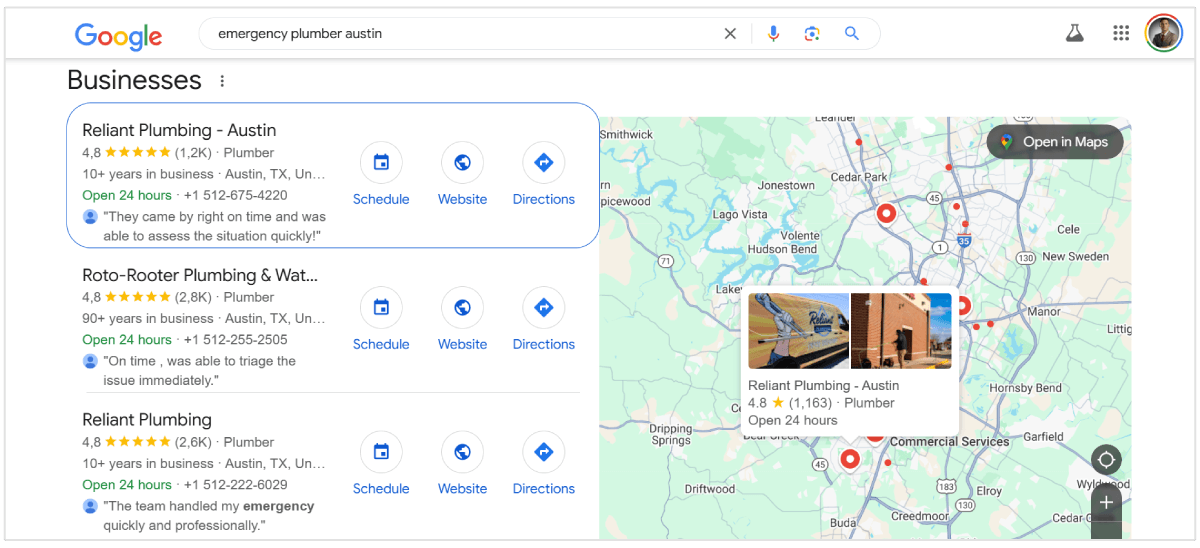
High rankings in Google Maps local pack can establish your business as a top choice in your local area, enhancing brand trust and recognition. It leads to increased website visits, more reservations, appointments, or sales, and more direction requests from the map pack listing.
After 7 years working in SEO, primarily on smaller, local businesses, I've found that some of the key metrics I use to measure their success in SEO come from analysing their local keyword rankings and SERP features, ensuring the website is attracting the ideal local customer base, and ultimately driving those all-important conversions, from foot traffic to online sales.
- Evie Sandall, Senior SEO Specialist at Assisted
You can track your local SEO rankings with the help of our Local Rank Tracker tool.
By setting up a GeoGrid, this tool visualizes your position in local search results within each grid square, corresponding to specific city blocks.
Each square on the grid shows your ranking at that precise location, providing deep insights into how your business performs in local searches throughout different areas of the city.
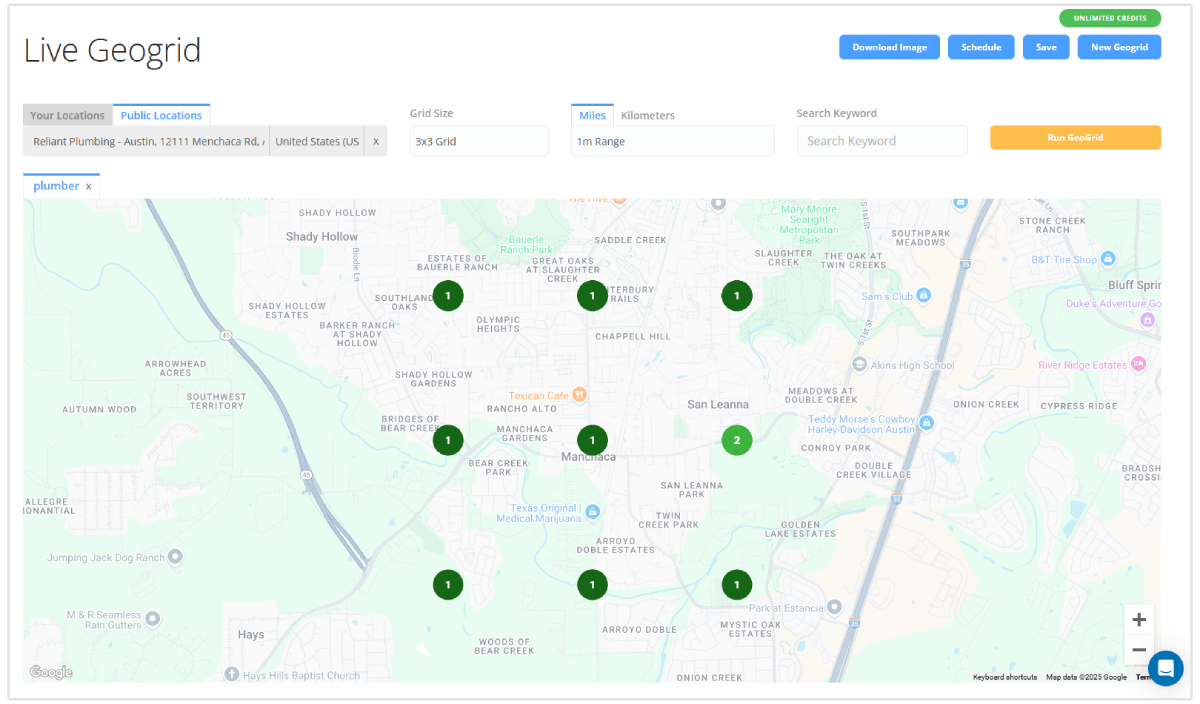
The tool can be customized extensively to fit specific search areas, ranging from a small 0.1 mile radius to up to 100 miles, and track changes over time.
The Live Geogrid measures the effectiveness of your SEO efforts visually on a dynamic heatmap.
You should monitor your rankings in Google Maps for both your business and your competitors to keep track of their progress. You can set reports to run daily, weekly, or monthly to measure your progress and stay ahead of your competitors.
Website Clicks and Traffic
The primary purpose of your local business website is to drive clicks and leads from geographically relevant areas.
Knowing the most visited pages helps improve your local SEO efforts.
A general increase in the number of visits or unique visitors indicates growing interest and reach.
You should track metrics such as page views per visit, average session duration, and bounce rate to learn how engaging and relevant your content is.
You can check the number of clicks to your target local landing pages with the help of Google Search Console.
Simply just add your website as a property in GSC.
And after your site is verified, you can begin tracking clicks to your website from local search queries.
Visit Search results under Performance in Search Console.
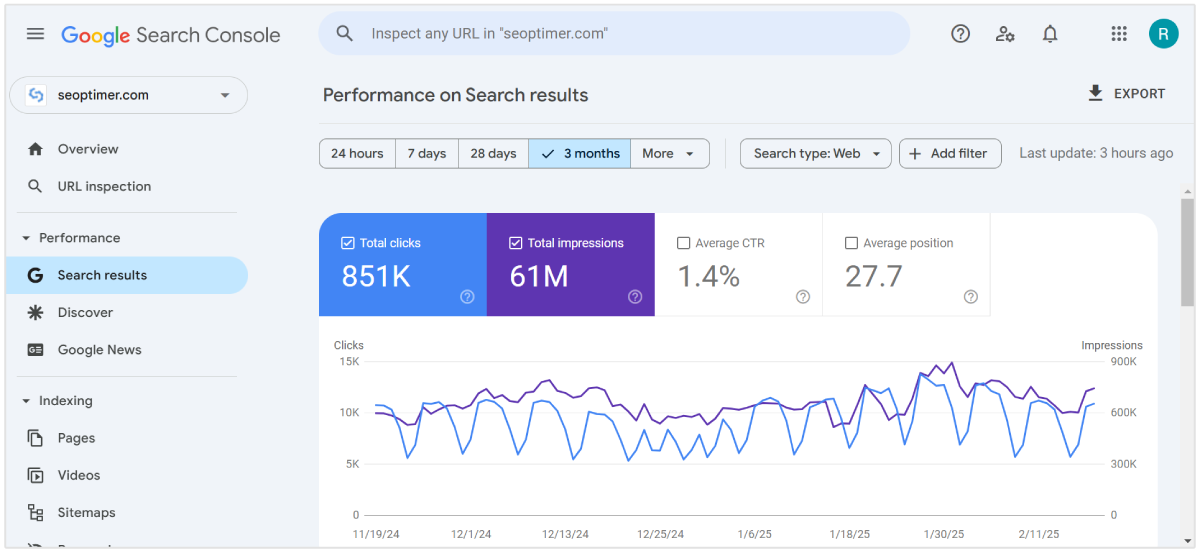
Now click on Pages to see the top landing pages and their clicks.
Regular measurement of clicks and traffic allows for ongoing optimization and quick responses to trends. You should also track spikes and changes in traffic during specific local SEO campaigns like local link building or regional content marketing.
It is also important to compare current data with historical benchmarks to minimize any content decay.
For example, tracking clicks and traffic to a page for the current period and comparing the data with the previous period helps you understand any gain or loss in clicks so that you can take appropriate actions to boost your SEO strategy.
Phone Calls
Combining SEO and call tracking lets you measure the actual return on investment from your marketing efforts.
You should attribute phone calls to geo-targeted keywords, landing pages, and local SEO campaigns. Doing so will help you gain an accurate picture of which pages and strategies are leading to overall business goals and revenue.
You can use CallRail to track phone calls from your Google Business Profile.
Once call tracking is set up, you can view all the essential call data in the dashboard section.
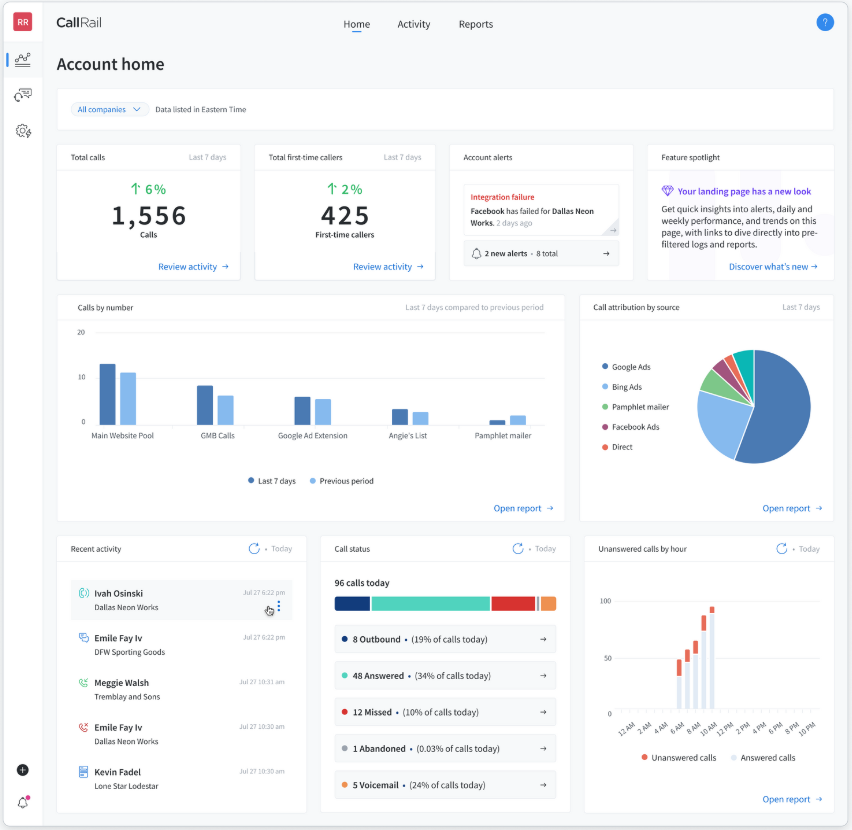
Insights from call tracking can be used to optimize your Google My Business profile, location-specific landing pages, and other local listings to improve call rates.
Google Business Profile Insights
The performance metrics offered by Google Business Profile are designed to provide a detailed view of how your business is performing in local searches.
Personally, I believe that Google Business Profile actions and website conversions are two of the most useful indicators for local SEO.
If people are finding you in search and taking action to engage with your business by calling, booking or visiting your site, that’s a sign your SEO is working.
- Yasmin Cotton, Digital Marketer & Founder of Elyrium
These metrics include:
- Search Queries: Shows the terms people are using to find your business, allowing you to optimize your content and SEO strategies based on popular and relevant search terms.
- User Views: Indicates the number of unique users who have viewed your profile, helping you gauge the reach of your business in the local area.
- Direction Requests: Tracks how many customers are requesting directions to your location, a direct indicator of intent to visit.
- Calls and Website Clicks: Measures engagement through the number of clicks on the call button and visits to your website from the profile, providing insights into how effectively your profile converts interest into action.
- Messages and Bookings: Monitors the interactions via messages and the number of bookings made through the profile, applicable to services that require appointments or reservations.
To find and access the performance report for your Google Business Profile, Go to the Google Business Profile Manager.
Sign in with the Google account associated with your Business Profile, then select Performance from the options available.
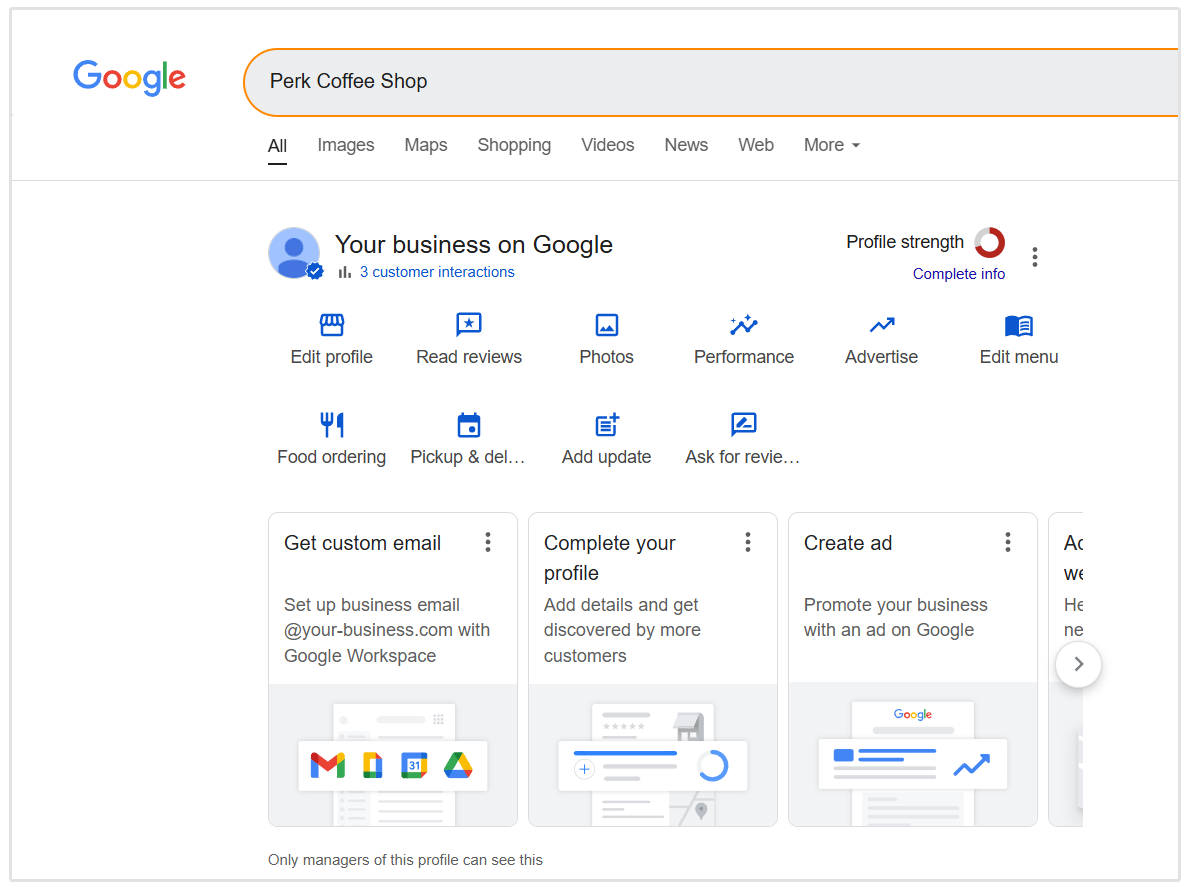
At the top of the Performance dashboard, you’ll see an option to select a date range. Click on it, choose your desired range, and then click Apply to update the report with data from that period.
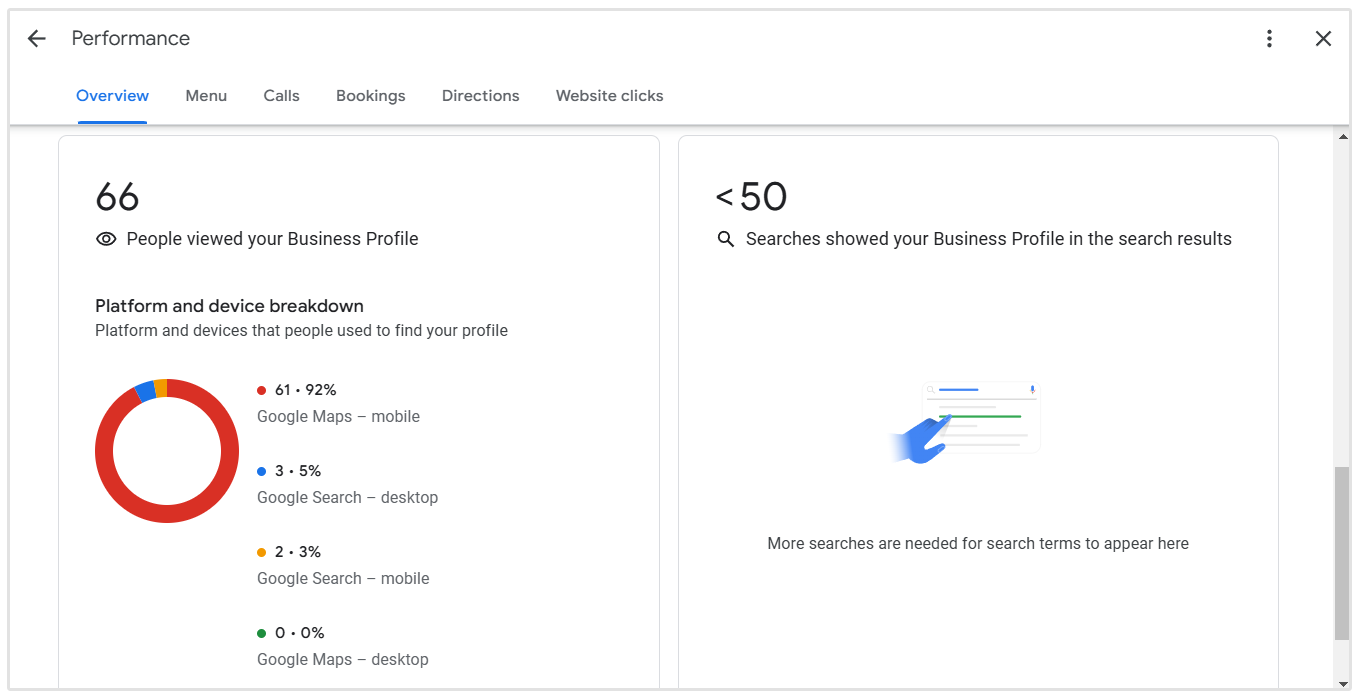
Number of Reviews Generated
Search engines like Google use reviews as a ranking factor. More reviews and positive ratings can improve your business’s visibility in local search results.
We also pay close attention to customer interactions, especially reviews and engagement. Reviews aren’t just for reputation; they play a direct role in rankings and conversions.
A steady stream of high-quality, recent reviews shows Google (and potential customers) that the business is active, trusted, and relevant. We encourage clients to consistently gather and respond to reviews, it’s a small effort with a big impact.
- Chris Coussons, Founder of Visionary Marketing
You can view the number of reviews on your GBP listing when you search for your business on Google.
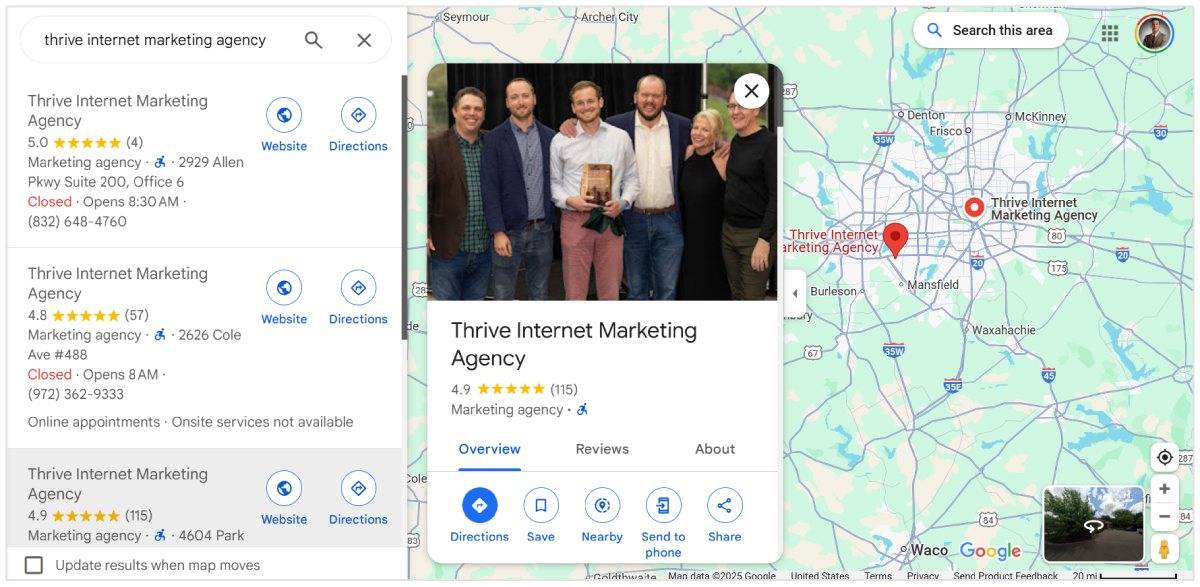
You should regularly check your Google Business Profile to view and manage reviews. You can find the information in the Reviews tab of your GBP profile.
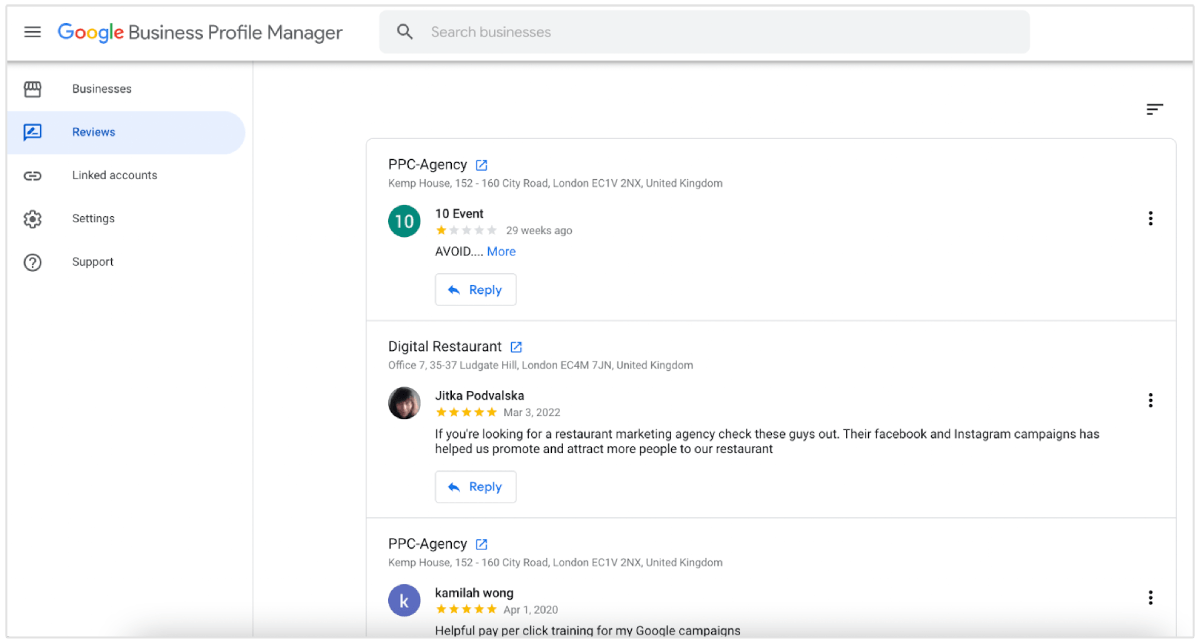
Our Google Review Management tool automates the process of managing, responding to, and prioritizing reviews across multiple Google Business Profiles.
The tool can handle reviews from 10s and even hundreds of locations.
The software’s advanced filtering system enables swift identification of negative or unresponded reviews by sorting through various criteria such as account, listing, rating, date, and response status.
Local Backlinks
Search engines see local backlinks as indicators that your business is relevant and authoritative in its geographical area.
Dofollow editorial backlinks with natural anchors are the best for your website. You should track the number of backlinks acquired from new referring domains in the current period and compare it with the previous period.
Also, check the number of dofollow, nofollow, UGC, and sponsored links. Your link profile should have a mix of each, while the majority of inbound links should be dofollow.
Natural and editorially-given links have the maximum impact on your local SEO strategy.
You should also measure the Domain Strength of the domains pointing to your website. Dofollow links from high domain strength sites pass more link equity and help your site rank high in local search.
SEOptimer’s Backlink Monitoring Tool helps you keep track of inbound links and shows the overall Domain Strength.
You can check the domain and Page Strength, the link type (dofollow or nofollow), the referring page, and the linked page anchor.
Local Citations
Local citations are mentions of your business on the web, which include any combination of your company name, phone number, address, zip or postal code, and website address.
Citations can occur on local business directories, websites, apps, and social platforms. High-quality citations from well-respected sites can increase the perceived reliability and legitimacy of your business.
This trust factor influences both search engine rankings and consumer behavior.
Monitoring citations allows you to manage your brand reputation effectively. It ensures that the information about your business is correct and up-to-date, enhancing trust among potential customers.
You can track citations using the Brightlocal Citation Tracker. It tracks and audits existing citations, identifying errors, and spotting duplicate listings.
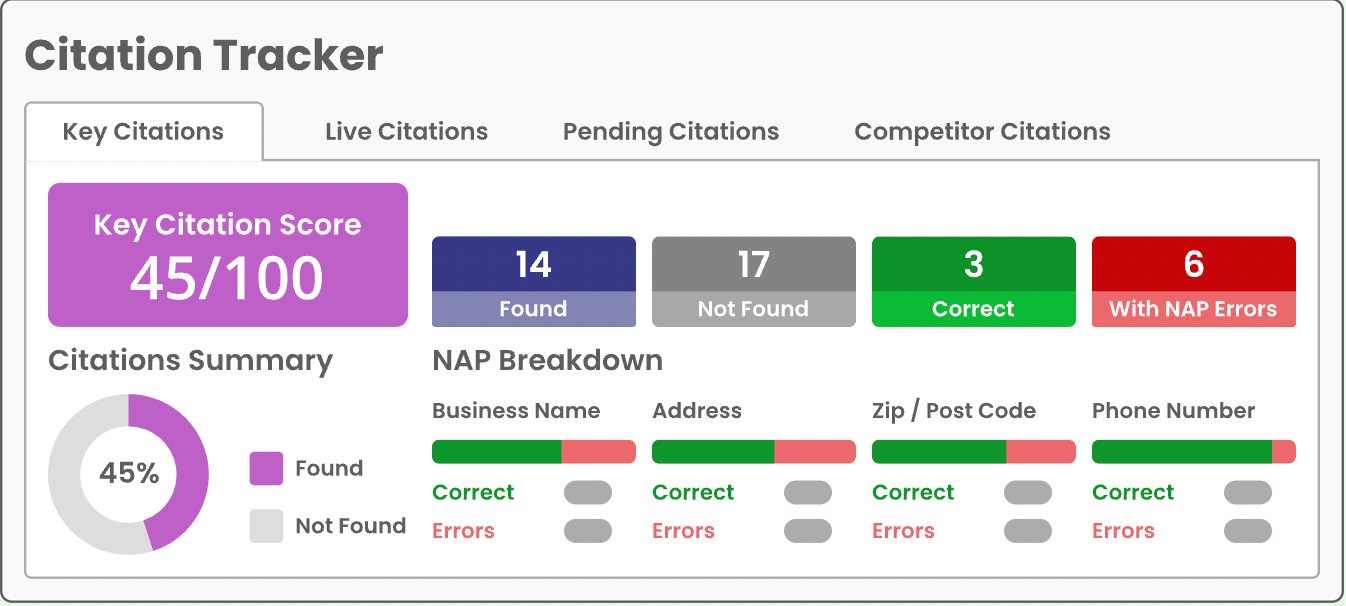
It also automates the discovery of new citation opportunities and provides competitive insights by showing where competitors are listed, but your business is not.
You should review your citations at least quarterly or bi-annually. Monitoring your citations ensures that any changes to your business (like a new address or hours of operation) are reflected across all your listings.
Accurate citations impact local search rankings and help people discover your business in your target areas.
Conversion Rates
Good conversion rates directly impact your revenue. A high conversion rate means a larger percentage of people who find your business locally are taking desired actions like calling, making a purchase, or filling out a contact form.
The best ways to measure local SEO success is by tracking conversions. No business invests in an SEO campaign just to grow their traffic; they want more leads for an ROI.
- Ben Duffy, Client Development Manager at Quirky Digital
You can track conversion rates with the help of Google Analytics. The different events that you can track using GA are:
- Downloadable content interactions
- Calls
- Newsletter sign-ups
- User registrations
- Social media button clicks
- Event registrations
Configure your GA4 settings with the help of the GA assistant to capture the right data.
You can modify options like how long data is kept, the duration of user sessions, and settings for tracking users across multiple devices to increase the reliability of your data.
After setting up your GA4, dedicate time to confirm that all potential lead generation mechanisms on your website are correctly monitored.
Conclusion
The right performance indicators in local search metrics provide a data-driven foundation for assessing and refining your SEO measurements.
By using metrics that track performance, traffic, leads, and conversions, businesses can achieve a results-focused strategy that boosts their visibility in local pack rankings.
Monitoring the top local SEO metrics is not just about tracking growth; it's about ensuring ongoing optimization that aligns with your local SEO goals.
The correct application and analysis of prominent SEO success indicators for local businesses help them drive tangible improvements in their local search presence.






